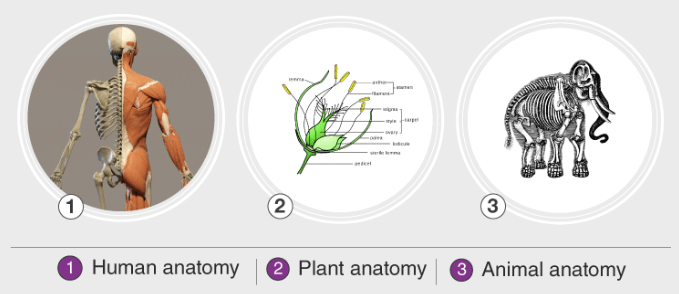Types of Anatomy
Anatomy is a branch of biological science which is concerned with the description of body structures of various living organisms as revealed by dissection.
The word anatomy is derived from the Greek word “anatomē”, where “ana” means “up” and “tome” means “cutting.” Originally, anatomy was first learnt by cutting up corpses, hence the name “anatomy.”
What is Anatomy?
Anatomy is the name of the science that studies the internal structure of living beings, be they animals or plants, using the dissection technique.

This word is of Greek origin and includes the particle ana, which means “above or above”, and tome, which means “to cut”. The doctor or scientist who is especially dedicated to this subject is known as an anatomist.
Types of Anatomy
Anatomy could be classified into:
Human Anatomy – Human anatomy involves the study of the physical structure of the human body. It focuses on numerous systems, including circulatory, digestive, endocrine, skeletal, lymphatic, nervous, respiratory, urinary, reproductive and muscular systems.
Plant Anatomy – Also called the phytotomy. It is the study of the internal structure of a plant including the tissues, root system, stem, leaves, flower, fruit and seeds.
Animal Anatomy – Also called the zootomy. It deals with the study of the interna
History of anatomy
It is a fundamental discipline for medicine, very old. The Egyptians had already documented the forms of different viscera on papyrus, although they knew little about their functions. Scientific anatomy is believed to have originated with the so-called Alexandria school, where human corpses were dissected and the first autopsies were performed.
Herófilo was the first great figure of Greco-Latin anatomy, it was he who described the fourth ventricle and studied in detail the anatomy of the eye, veins and arteries, the genital apparatus, among others. He also interpreted the pulsations of the arteries associated with the functioning of the heart.
Around the same time, Erasistratus documented the tricuspid valve, the brain, distinguished the sensory nerves from the motors, and described the trachea, heart, and vascular system. Another key anatomist of antiquity was Rufus of Ephesus.
The notions of anatomy and physiology that emerged managed to give rise to the concept that diseases are often associated with alterations in the internal organs, and not with a system of humor, which was what was used to think at the time.
The ancient Romans and the Arabs also made their contributions. But modern anatomy is considered to begin with the work of the Belgian Andreas Vesalius, whose important contribution appears in De humani corporis fabric (1543).
Being a complex science, anatomy has been subdivided into several branches. Among them we can mention:
- The descriptive or systematic anatomy, which investigates the shape and relationship of the structures
- The topographic (or regional) anatomy, which studies the structures taking into account regions
- Comparative anatomy, which compares the structures of different animals
- The pathological anatomy, which stops at the alterations observed in a disease situation
Anatomy and art
The anatomy and art of the representation of the human body in fine detail have been developed almost in parallel, especially during the Renaissance, and this is how paintings and sculptures were made in which the human muscles and veins, for example, assume impressive realism.
A complete example of this can be found in Michelangelo’s David, in Florence. There is also a famous painting, The Anatomy Lesson of Dr. Nicolaes Tulp, by Rembrandt, where a group of surgeons is seen next to the bed where a lifeless body lies, and in a prominent position, Dr. Nicolaes Tulp, an official anatomist of Amsterdam.
It is interesting to note that the body portrayed (this was a commissioned work) belonged to Aris Kindt, a criminal hanged that same day. At that time only one public dissection was allowed per year, in winter (to allow the body to remain in good condition for a longer time).